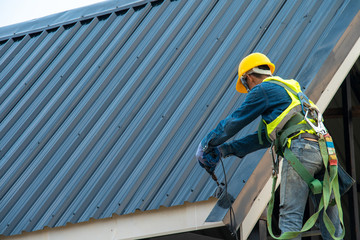Roofers install, repair, and replace the roofs of homes and other buildings. They use various materials, including shingles, asphalt, gravel, rubber, thermoplastic, and metal. Roofing work can be physically demanding and dangerous. Workers must be strong and not afraid of heights.

Roofers are experts at removing old roofing and installing new shingles or panels. They also install flashing to protect your home from water damage around chimneys, windows, and joints. A roofer is a skilled tradesperson specializing in installing, maintaining, and repairing roofs on residential, commercial, and industrial buildings. The primary duties of a roofer include:
Roof installation: A roofer is responsible for installing various roofing materials such as shingles, tiles, metal panels, and flat roofing systems. They must follow building codes and manufacturer guidelines to ensure that the roof is installed correctly.
Roof repair: A roofer is responsible for repairing any damage to a roof, such as leaks, cracks, or missing shingles. They must assess the damage and determine the best course of action to fix the problem.
Roof maintenance: A roofer can also provide regular maintenance to ensure that the roof remains in good condition. This may include cleaning gutters, removing debris, and inspecting the roof for any signs of damage.
Safety: A roofer must also prioritize safety on the job site. They must follow safety guidelines and use proper equipment to prevent falls or other accidents.
The process starts with thoroughly inspecting your property and the roof sheathing to determine if it’s time for a reroofing project. They will then start by measuring the rafters, heights, eaves and ridge lengths to prepare an accurate quote for the job.
Once the measurements are complete, they’ll draw up a detailed plan of your property to ensure that everything is properly prepared for the installation process. This will help them avoid damaging your landscape, furnishings or pets while completing the work.
The shingles are placed on your roof in layers, staggered and nailed, or screwed in. This is a crucial step to ensuring your new roof will look good and function properly.
Roofers repair, replace and install the roofing materials that cover buildings, from shingles to metal. They must be familiar with all aspects of roof maintenance and repair to do the job right. They are also on the lookout for the latest and greatest in roof products and services to keep them up to par.
The best way to avoid the hazards of roof repair is to have a regular inspection of your rooftop. This includes checking the flashings, a small but important component in making your roof water tight.
A well made, high-performance roof is a smart investment that will protect your home from the elements for years to come. The right roofer can save you money by identifying problem areas before they become costly repairs. If you are looking to hire a roofer, make sure you ask about their credentials and check out their work for yourself. You may be pleasantly surprised by the quality of work they perform.
Roofers install roofs on buildings to prevent water leaks, which can damage interiors, equipment, and furnishings. They use a variety of materials, including shingles and bitumen.
They also remove and replace roofing material that is damaged or deteriorated, such as rotten wood. They clean the work area and equipment before beginning a job.
Roofing work is physically demanding, especially when working high off the ground. Workers can slip or fall off ladders, or be burned by hot bitumen.
Roofing companies are large businesses with multiple crews that are often available for your project. They can also offer long-term warranties and competitive prices.
A roof can be a significant investment, and it’s important to ensure that it stays in good condition for as long as possible. Regular inspections and maintenance can help you catch problems early, saving you money in the long run.
Roofing maintenance extends the life of your roof, preventing damage that could cost you thousands of dollars to repair or replace. It also helps keep your property safe for occupants and reduces the likelihood of mold growth.
It can increase your home’s energy efficiency, which can lower your utility bills. It can also protect your property from weather-related damage, such as rain and snow.
Building owners should consider a roof maintenance plan that offers yearly inspections and preventative repairs, such as caulking or sealant replacement. This preventative maintenance can extend the life of your roof and keep it under warranty.